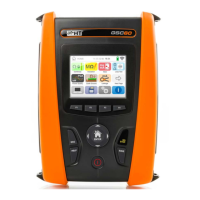GSC60
EN - 56
2.
Move the slide bar reference in the position "1T" for the
selection of the test with 1 terminal or in the position
"2T" for the selection of the test with 2 terminals.
Confirm the choice by going back to the following initial
measurement screen.
3. Insert the blue and black connectors of the single cables in the corresponding input
terminals of the instrument B4, B1 (2T measurement). Insert in the free end of the cables
the corresponding alligator clips or tips. It is also possible to use the remote lead by
inserting its multipolar connector into the input lead B1. Connect the alligator clips, the
tips or the remote lead to phase L1 and N according to Fig. 23 and Fig. 24.
4.
Press the GO/STOP key on the instrument or the
START key on the remote lead. The instrument will
start the measurement. During this whole stage, do not
disconnect the measuring leads of the instrument from
the system under test.
The symbol for the tip on phase L1 and the hourglass
indicating the status of pending recognition of a voltage
higher than the maximum allowed.
5.
Once the correct voltage recognized, the symbol is
shown on the display. The instrument gives out a long
sound until input voltage is present.
6. At the end of phase L1 acquisition, the instrument is in
standby waiting for the signal on phase L2 and showing
the symbol of "disconnected tip" as shown in the screen
to the side.
Under these conditions, connect the alligator clips, the
tips or the remote lead to phase L2 and N in
accordance with Fig. 23 and Fig. 24.

